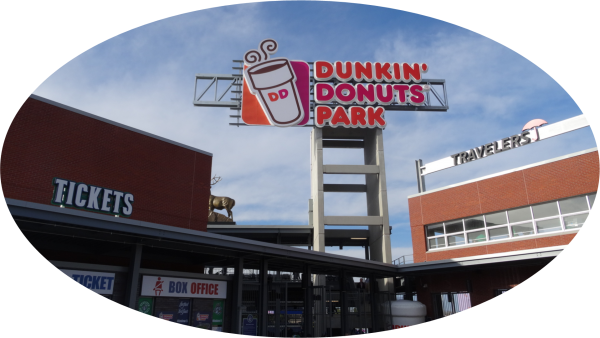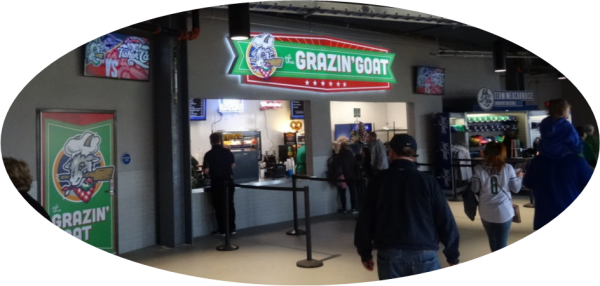by Richard A. Robinson
Let's face it, regardless of one's political leaning, economic philosophy, or cultural beliefs, we are in the midst of great turmoil. In the face of so much uncertainty, I initially found it somewhat difficult to be both sincere and inspiring. But as I continued preparing, I realized that I had been looking for inspiration in all of the wrong places.
In our busy lives, we turn to video clips and sound bites for news and let the tenor of these brief snippets shape our outlook. Our mood is at the mercy of headlines, news feeds, and 140 character messages. We are accustomed to looking to our leaders and other public figures for encouragement and inspiration, and when it isn't readily available, we are easily discouraged. So, in times like these, we need to think a little bit more about the sources of our hope, encouragement, and inspiration.
When you think about it, doesn't real inspiration come from the people we live with, the people that we work with, and the people that we interact with on a daily basis? People who work hard and do their best to make the world a better place in their own unique way. People who make a commitment to something worthwhile and important, just as all of you have done.
The bottom line is that the reason we are celebrating today is because you are the future. The direction we will follow as a profession, as a nation, and as a world, is up to you. Is that a bit scary? It should be! But it should also be exciting and exhilarating. As you graduate and prepare to embark on your career in the law, you hold tremendous power. On this most important day, I'd like for you to think about that power and to truly comprehend its significance.
 So what does this mean for you? It means that, as you begin your career in the law, it is essential for you to understand that your obligations as an attorney extend far beyond the interests of your clients. They extend to the justice system, to the legal profession, and to society at large.
So what does this mean for you? It means that, as you begin your career in the law, it is essential for you to understand that your obligations as an attorney extend far beyond the interests of your clients. They extend to the justice system, to the legal profession, and to society at large.
William Shakespeare focused on this duality in his play Henry the Sixth. The play includes a scene in which a character named Jack Cade, the leader of a rebellion against the crown, muses about what he would do if he were king. It is then that one of his followers, Dick the Butcher, utters what I believe is the most misunderstood line in all of Shakespeare's writings: "The first thing we do, let’s kill all the lawyers." Cade heartily agrees. i
While many people believe that Shakespeare was expressing society's frustration with the lawyers and the legal profession, others, including myself, believe that he was actually paying us the ultimate compliment by pointing out that lawyers and the rule of law are the only things protecting society from anarchy. If you want to bring down society and render the people powerless, the first thing that you must do is get rid of the rule of law and all those who fight to protect it.
John Curtin, a former president of the American Bar Association once remarked that "[a]nyone who believes a better day dawns when lawyers are eliminated has the burden of explaining who will take their place. Who will protect the poor, the injured, the victims of negligence, the victims of . . . discrimination, and the victims of . . . violence? . . . Lawyers are the simple yet essential means by which people seek to vindicate their rights and we must not foreclose that means." ii
As you prepare to enter the practice of law, I urge you to think about the power that you hold, and strive to balance your obligation to your clients with your duties as an officer of the legal system. Our profession needs individuals who understand that, when a single attorney starts to chip away at the rule of law in order to secure an easy win for their client, it undermines the bedrock of our society. I recognize that, at times, this may not be easy. This is why our profession is in dire need of individuals who are willing to devote their time to working through these issues. Our small steps matter.
What we do every day affects the way that our profession is perceived by the public. The way that we act in the courtroom, the tone of voice that we employ, and whether we choose to treat others with dignity and respect. Our everyday words and deeds express our commitment, or lack thereof, to a fair and effective justice system. The simple decision to conduct ourselves in a manner that fosters respect also builds respect for what we do. When our own actions are added to those of our colleagues, we have an effective force for improvement.
If each of us strives to balance our duties to the public with our commitment to fairness, justice, and the rule of law, it will go a long way to restoring the public's faith in our profession and our legal system as a whole. This is particularly important in times of uncertainty. As you embark on your legal career, I urge you to keep this balance in mind. In doing so, you will serve as a source of inspiration and motivate others to take similar action.
Today you are taking a great step in your journey toward the practice of law and, on this special occasion, we celebrate the success that comes from many years of your hard work, sacrifice, and dedication. You have achieved a major goal by making major sacrifices. However, as others have said, what you get by achieving your goals is not as important as what you become by achieving your goals. The power to practice law brings not only the financial ability to support yourself and your family; it also brings along with it the responsibility to assist others and to help shape the legal profession of the future.
We are a remarkable people, living in a remarkable country, with a remarkable system of laws and justice, yet we are not perfect. As a quinquagenarian, I can remember some very turbulent times, the crescendo of the civil rights movement, the assassination of a United States President, a Presidential candidate, and several national civil rights leaders. I remember what happened at Kent State, and the burning of some of our major cities. These are the type of things that have destroyed other nations. Yet, we did more than survive; we thrived. So what saved us? What was different?
I believe that it was the hard work, dedication and sacrifices of people like you. People that chose paths similar to the ones that brought you here today. People who know that a lawyer assumes not only an obligation to their clients, but also solemn duties as an officer of the legal system and a public citizen having special responsibility for the quality of justice.
The oaths that you will eventually take and various rules, laws and regulations related to the practice of law are all designed to help you reach this lofty goal; you would be wise to heed them. But make no mistake, what I am asking you to do runs much deeper.
The legal profession is a noble one, but it is often greatly misunderstood. Many assume that lawyers are merely troublemakers that bring lawsuits that should not be brought and defend that which should not be defended. In reality, the law is the very fabric that holds our society together and, as lawyers, you bear the responsibility of being its tailors.
Look at any form of mass media today and you will see that we are living in interesting and troubling times. Both present events and those which lie on the horizon will stretch this fabric beyond its tearing point. As lawyers, you bear the tremendous burden of mending any rift that may occur.
Bear this responsibility well. Approach it with civility, reason, respect, compassion, and great purpose. The cold dispassionate procedures and technicalities of the legal profession often makes people think that lawyers are more interested in money, papers, forms, and procedures than they are in the everyday struggles of life.
People go to lawyers because they believe them to be problem solvers that will help them get through life's struggles. It would be a great disservice to let them leave feeling that they were not heard or, even worse, believing that your involvement not only failed to put out the embers of their angst, but fanned the flames that eventually consumed them.
Remember that you are more than just a representative of your clients. You are an officer of the legal system and a public citizen having special responsibility for the quality of justice. Persuade when you can, compromise when you should, and fight when you must.
Your responsibilities as lawyers will be great. You are the tailors of the very fabric of our society. Although you may never receive a hero's welcome for the work that you do, please know that you are our heroes.
I ask that you do more than just follow the rules, oaths, laws, and regulations that I mentioned earlier. I ask you to fully accept your responsibilities as lawyers, and to continue to listen ever so closely for that subtle tearing sound because you are the keepers of the cloth.
_________________________________
Richard A. Robinson is an Associate Justice of the Connecticut Supreme Court. He graduated with a Bachelor of Arts Degree from the University of Connecticut in 1979 and a Juris Doctor degree from West Virginia University School of Law in 1984. Justice Robinson’s career is complimented by an array of public and judicial service. This is an excerpt of remarks delivered on May 14 at the Commencement and Doctoral Hooding ceremony of the Quinnipiac University School of Law in the TD Bank Sports Center on the university’s York Hill Campus.
i WILLIAM SHAKESPEARE, THE SECOND PART OF KING HENRY THE SIXTH act 4, sc. 2.
ii THOMAS F. BURKE, LAWYERS, LAWSUITS AND LEGAL RIGHTS 24 (2002).









 since 1897. In 2015, Saint Francis became part of Trinity Health of New England, an integrated health care delivery system that is a member of Trinity Health, Livonia, MI, one of the largest multi-institutional Catholic health care delivery systems in the nation.
since 1897. In 2015, Saint Francis became part of Trinity Health of New England, an integrated health care delivery system that is a member of Trinity Health, Livonia, MI, one of the largest multi-institutional Catholic health care delivery systems in the nation. ted Nations and vetted by the State Department in a process that takes at least 18 months. By comparison, a million or so legal immigrants arrive annually. From October 2001 through 2016, Burma, Iraq, Somalia, Bhutan, and Iran are the top five nations that send refugees to the U.S.
ted Nations and vetted by the State Department in a process that takes at least 18 months. By comparison, a million or so legal immigrants arrive annually. From October 2001 through 2016, Burma, Iraq, Somalia, Bhutan, and Iran are the top five nations that send refugees to the U.S.
 There were nine states that had less than 500 refugees from a single country since October 2001: Alabama, Alaska, Arkansas, Delaware, Hawaii, Mississippi, Montana West Virginia and Wyoming.
There were nine states that had less than 500 refugees from a single country since October 2001: Alabama, Alaska, Arkansas, Delaware, Hawaii, Mississippi, Montana West Virginia and Wyoming.
 Early in Nikole's recovery, she knew she had to do something to help combat motor vehicle crashes caused by young drivers, the number one killer of teens in America. She met members of !MPACT (an acronym for Mourning Parents Act, Inc.) at a presentation she made at Cromwell High School. Not long afterwards, she began delivering her safe teen driving message with the !MPACT moms at high schools across Connecticut and into greater New England.
Early in Nikole's recovery, she knew she had to do something to help combat motor vehicle crashes caused by young drivers, the number one killer of teens in America. She met members of !MPACT (an acronym for Mourning Parents Act, Inc.) at a presentation she made at Cromwell High School. Not long afterwards, she began delivering her safe teen driving message with the !MPACT moms at high schools across Connecticut and into greater New England.



 Dunkin’ Donuts Park is the first brand new venue to open in the Eastern League since Northeast Delta Dental Stadium—home of the New Hampshire Fisher Cats—opened its doors in 2005, and it is seen as the biggest change to the league’s facility landscape since the extensive multi-phase renovation to the Harrisburg Senators’ FNB Field was completed prior to the 2010 season.
Dunkin’ Donuts Park is the first brand new venue to open in the Eastern League since Northeast Delta Dental Stadium—home of the New Hampshire Fisher Cats—opened its doors in 2005, and it is seen as the biggest change to the league’s facility landscape since the extensive multi-phase renovation to the Harrisburg Senators’ FNB Field was completed prior to the 2010 season.




 So what does this mean for you? It means that, as you begin your career in the law, it is essential for you to understand that your obligations as an attorney extend far beyond the interests of your clients. They extend to the justice system, to the legal profession, and to society at large.
So what does this mean for you? It means that, as you begin your career in the law, it is essential for you to understand that your obligations as an attorney extend far beyond the interests of your clients. They extend to the justice system, to the legal profession, and to society at large.




























